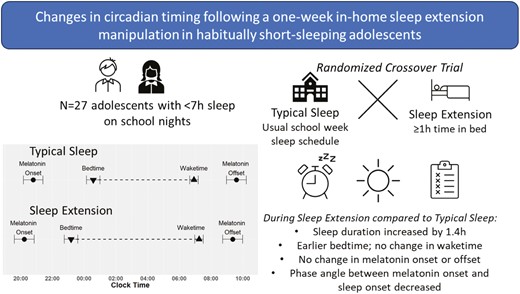-
Views
-
Cite
Cite
Sydney Holtman, Emily Cooper, John T Brinton, Anne E Bowen, Stephen Hawkins, Melanie G Cree, Kristen J Nadeau, Kenneth P Wright, Stacey L Simon, Changes in circadian timing following a 1-week in-home sleep extension manipulation in habitually short-sleeping adolescents, Sleep, Volume 48, Issue 2, February 2025, zsae273, https://doi.org/10.1093/sleep/zsae273
Close - Share Icon Share
Abstract
Evaluate objectively measured circadian rhythms following 1-week of at-home sleep extension in habitually short-sleeping adolescents.
Twenty-six participants (16.1 ± 1.2 years, 69% female, and 65% White non-Hispanic) with insufficient sleep (≤7 h on school nights) were randomized to 1 week of typical sleep (TS; usual school schedule) and sleep extension (EXT; ≥1-h additional time in bed) in counterbalanced order with a 1-month washout between conditions. Home monitoring of actigraphy-estimated sleep and light exposure was assessed during both weeks. Hourly in-laboratory evening/morning dim-light salivary melatonin samples were obtained and onset (DLMOn) and offset (DLMOff) were calculated following each condition.
Sleep duration increased by 1.37 h (95% CI = 1.09, 1.66; p < 0.001), bedtimes advanced by 1.40 (95% CI = –1.75, –1.06; p < 0.001), and waketimes did not significantly change (p = 0.055) during EXT compared to TS. There was no change in DLMOn or DLMOff following EXT (both p > 0.05). The DLMOn-sleep onset phase angle narrowed by 0.72 h (95% CI = –1.39, –0.07; p = 0.04) during EXT. Light exposure within 2-h of bedtime was significantly higher during EXT compared to TS (23.37 vs. 7.73 lux; p = 0.048).
Sleep extension did not change melatonin onset or offset but may have increased circadian alignment. Further research should evaluate the addition of specific strategies to improve circadian timing such as morning bright light in combination with sleep extension.










Comments